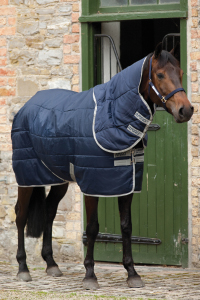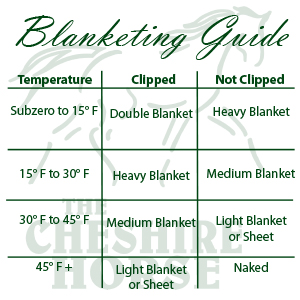Turnout vs. Stable
Turnout blankets are designed to be worn outdoors regardless of the weather. They’re waterproof, breathable, and more durable than stable blankets. A properly fitting stable blanket tends to weigh a little less than a turnout, putting less pressure on your horses while they are in the barn. If your horse is stabled inside at night and turned out during the day, a good option is to use a stable blanket with a turnout sheet over it while your horse is outside. Shop turnout blankets here and stable blankets here.
 Denier: What is it? And what do the numbers mean?
Denier: What is it? And what do the numbers mean?
Denier is a word used to describe the threading and how tightly woven the fabric of the blanket is. The higher the number, the tougher the outer shell of the blanket. Generally, higher denier blankets also tend to have a stronger waterproofing. Most people will not go lower than 600 denier for their turnout sheets or blankets. A 1200+ denier blanket is the best choice for horses that are tough on blankets or who are turned out with other horses that tend to be rough on blankets. Ballistic nylon is the toughest type of blanket and is the least likely to tear.
 Lite, Medium and Heavy
Lite, Medium and Heavy
A lite weight blanket generally refers to a sheet with no poly fill. A medium weight blanket usually has between 180-220 grams of fill. A heavy weight usually has between 300-370 grams of fill. Some companies make an extra heavyweight blanket which has closer to 400 grams of fill. There are some blankets that offer 100 grams of fill, which is a great weight for horses on an day too warm for a medium weight but still too chilly for just a sheet!
How should my horse’s blanket fit?
The neck area should be snug — not too tight and not too loose! A blanket that is too loose through the neck will tend to slide back and can put a lot of pressure on your horse’s withers. A blanket that is too tight tends to rub the shoulder area and withers. You should be able to run your hand between the blanket and your horse.
The chest area should overlap slightly on either side. When the blanket overlaps a little bit, it will help keep your horse’s chest warm and less drafty. You should be able to buckle the chest buckles tight enough to help hold the slight overlap in the blanket, but it should not be so tight that it causes the blanket’s shape to distort on the horse’s back or causes pressure points around the horse’s chest and wither area.
The sides of the blanket should drop down far enough so you cannot see your horses belly, but should not be far enough down to reach your horses knee or hock. If your blanket is too short, your horse will lose some heat from the belly area. Cross surcingles should be fastened so you can fit a hand’s breadth between the surcingles and the horse’s body. This means that the straps are tight enough to prevent legs from becoming caught should the horse lie down, but not so tight that the horse will be uncomfortable.
The hindquarter area should be covered entirely, but the blanket should not reach all the way around to the tail unless the blanket has a tail flap.
For more resources on blanketing, check out…
- High Neck Blankets
- V-Front Blankets
- Clip Front Closures
- Hoods & Neck Covers
- Leg Straps
- Layering
Our guide to Blankets for Every Equine (and Animal):
- Growing Horses and Other Animals
- Ponies and Miniature Horses
- Draft Horses
- Narrow and Wide Chested Horses
- “Houdini” and Wrecker Horses
- Measuring for a Blanket
- Dog Blankets

